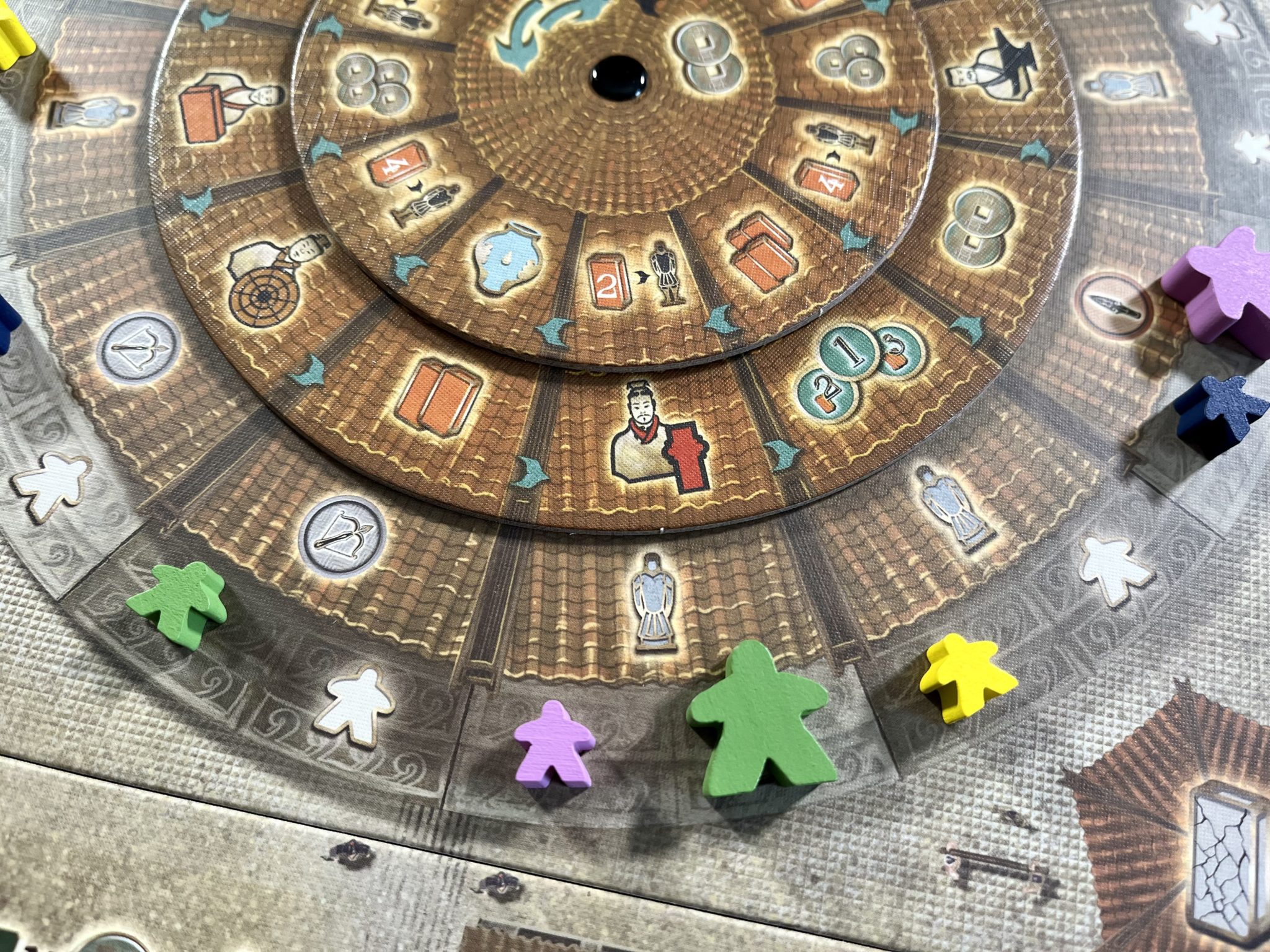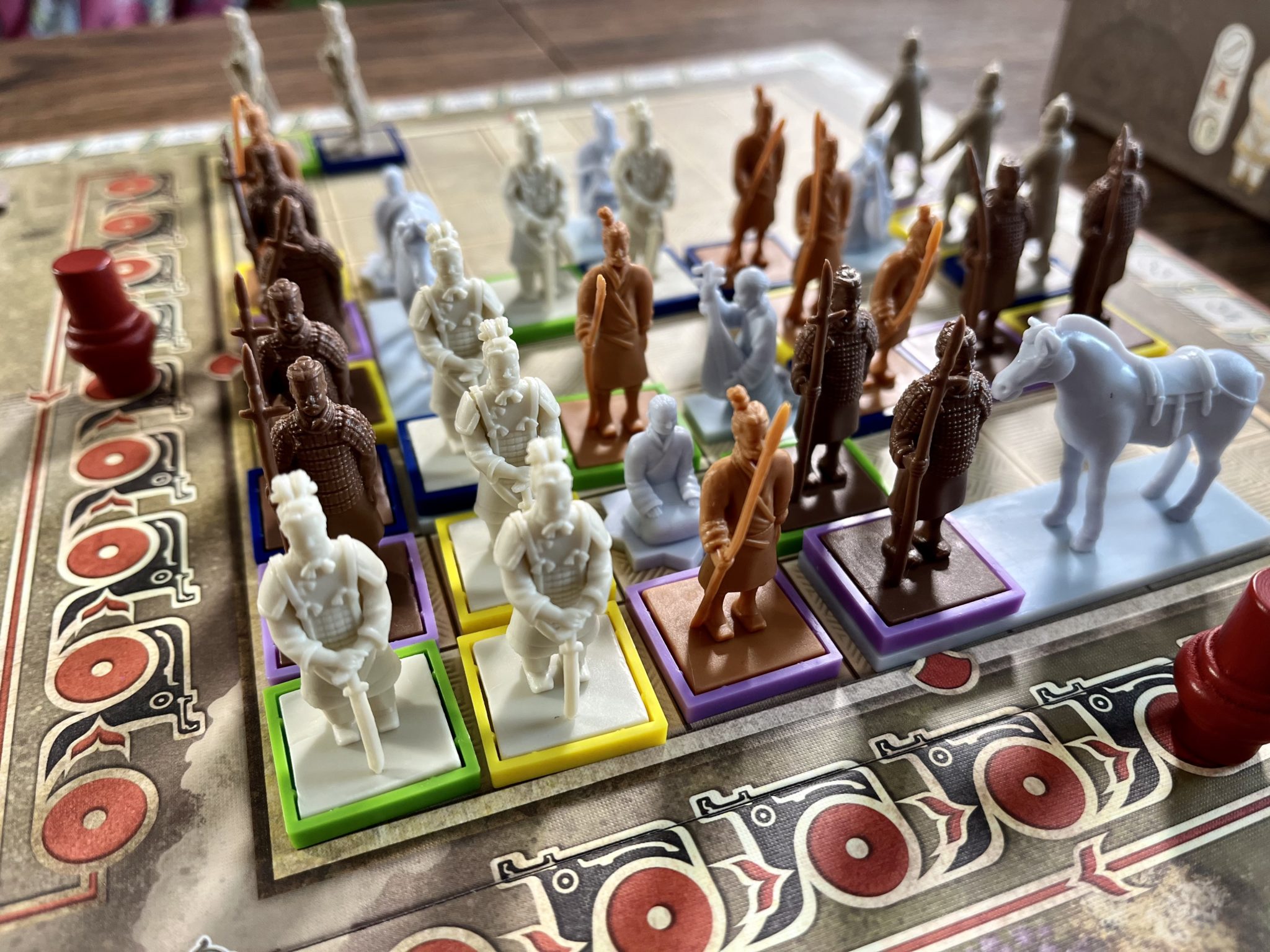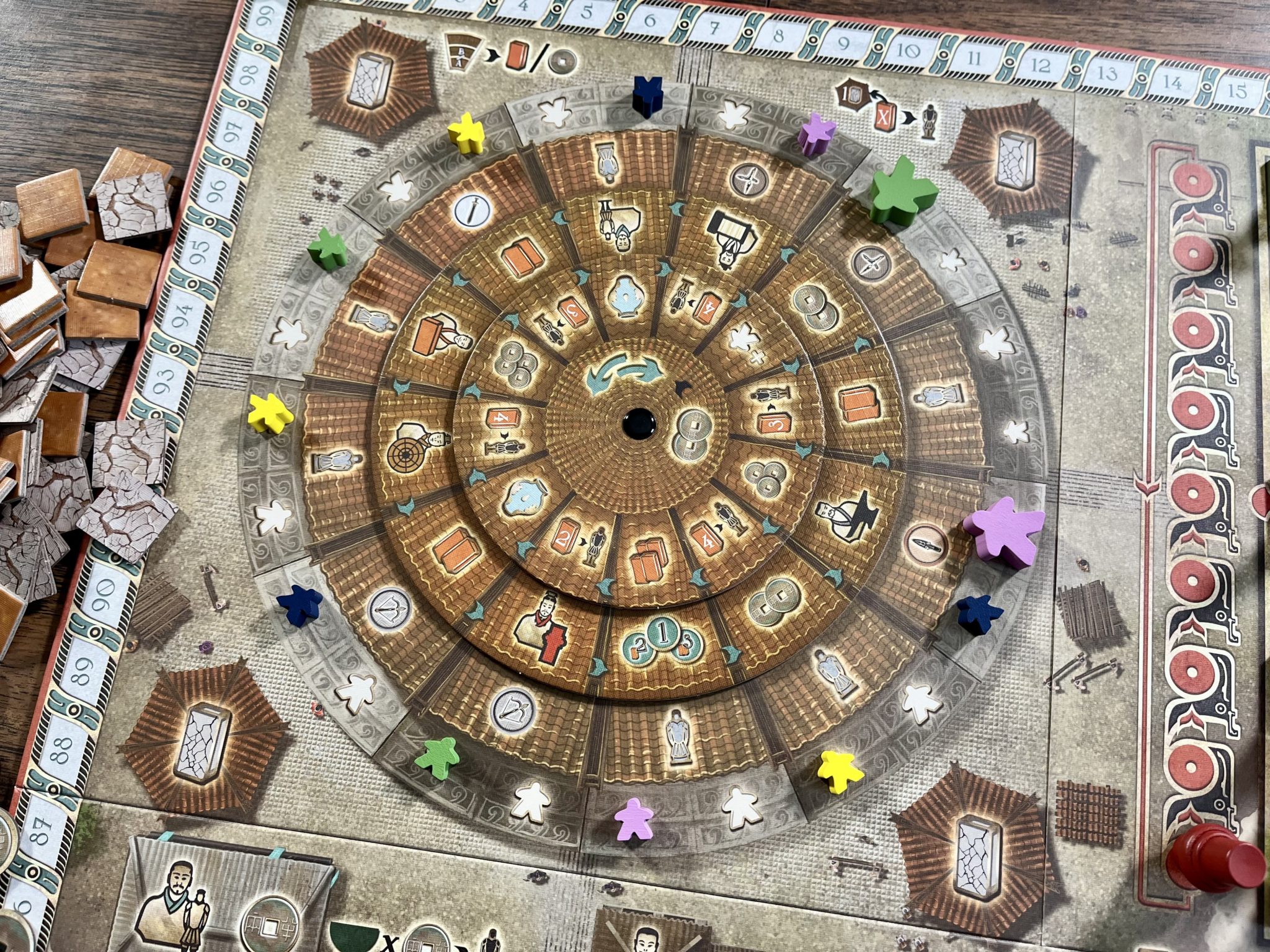Terracotta Army is a Euro board game published by Board & Dice. In the game the Emperor has passed away, and to protect him in the afterlife, a great army of statues are assembled to stand guard of the Emperor’s tomb. You and everyone else at the table are tasked with building this army out of clay. Although all players will be making this army together, the player who scores the most points during the game wins. Players assign their craftsmen or artisans to take actions in the game. Each different type of statue gains points differently, and it’s up to you to figure out the best way to assemble the army.
Board & Dice is known for their euro designs of medium weight board games, and this one is one of my favorite recent addition of their collection.

What’s in the Box?
- 1 Game Board
- 2 Action Rings
- 1 Plastic Pin
- 1 Cardboard Warrior Organizer
- 2 Inspector Pawns
- 1 Round Marker
- 3 Priority Tokens
- 4 “100 VP/200 VP” Tokens
- 12 Scoring Tiles
- 90 Double Sided Clay Tokens
- 90 Cardboard Coins
- 11 Plastic Officers
- 11 Plastic Guards
- 11 Plastic Soldiers
- 11 Plastic Crossbowmen
- 4 Plastic Musicians
- 4 Plastic Footmen
- 4 Plastic Kneeling Archers
- 4 Plastic Horses
- 16 Cardboard Weapon Tokens
- 24 Cardboard Master Tokens
- 4 Wooden Scoring Markers
- 4 Wooden Turn Order Markers
- 20 Wooden Craftsmen Meeples
- 20 Wooden Artisans Meeples
- 60 Plastic Warrior Bases

How’s it Play?
Each player starts with a number of craftsmen depending on the number of players in the game. During the game these can be changed into artisans, but still function similarly. At the beginning of their turn, a player places one of their craftsmen or artisans on a section of the wheel on the main board. Optionally before placement, a player can spend 2 coins to either move the inner wheel clockwise or the middle wheel counterclockwise. Rotating the wheel moves specific actions listed on that wheel to line up with other actions on the other wheels so you can place your meeple to take all those actions.

After optionally moving the wheel, place one of your meeples on a spot around the wheel and takes the actions from the inner wheel outwards, one at a time. If you place an artisans you can place it on a section where a craftsmen has already been placed, but after an artisan is placed, no one can place another meeple in that section.
One of the main ways to score points in this game is by placing statues. Each statue itself scores points when built, and then trigger its special action after placed. You pay its cost in wet clay. Take one and turn it over to the dry side to place in the warehouse in the quarter section of the action wheel. The remaining clay is returned back to the supply.
To take the special ability, you need to flip your matching weapon token over. This is not mandatory, and if you have the active side of the token up, you don’t have to flip it over to use the special ability if you don’t want to.

When taking the action to purchase a specialist statue you must pay its cost in coins and flip over the associated weapon token to its inactive side.
The last type of action to talk about is the master abilities. If you do not have a master token of of your color in the Master’s area, you pay the lowest cost token and use the ability associated with the depicted master. If you already have the master, you will be able to use the ability from that master. Each of these masters also have abilities that trigger between phases.
Scoring is done between rounds. First, inspectors are scored in whatever row and column the inspector is currently located. These inspectors can move with special actions to score differently depending on its location. Whoever has the most statues in each row scores 7 points, and the player with majority in each column scores 7 points. If you don’t have majority but have presence, you score 3 points. Next, musicians score 1 point for each warrior in the same row and column as the musician. Lastly, each round has a scoring tile associated with it. These tiles are all present at the beginning of the game so players can strategically win the points associated with these scoring tiles.
Between each round, cleanup is performed. Possible new first player is determined, and turn order is changed. All wet clay is flipped to dry unless the player has an ability to keep it wet. All workers are then returned unless it’s the last round where final scoring is determined. Each statues surrounding each footman scores 1 point each. Each statue is scored depending on the number of similar types of statues in its group. Kneeling archers are scored by the warrior it faces, that player scores 2 points. Lastly, for each leftover clay and coin, a pair scores 1 point. The player with the most points wins the game.

The Verdict
I first played Terracotta Army online during a demo session when the game was newly announced. I have since gotten the chance to play a physical copy, and actually put it on my game table. What’s the difference? The game feels a lot better when physically on my table. There are plastic miniatures that really give the game a better feel. It also makes it so you feel more like you’re making statues to guard the Emperor’s tomb.
But this is another one of those games where the rules are fairly easy to understand. All your actions are determined by the action wheel and manipulating the wheel to move certain rings to give yourself a better action is the meat in the game. There is a lot of choices and options that can be made, and doing the right actions at the right time can do wonders in the game. The game is a medium weight euro game with worker placement, and area majority. The worker placement is focused with the action wheel, while the area majority is focused on by the miniatures and filling in the mausoleum.
I think the design does a good job on having round objectives to score points at the end of each round. You can start planning to do well in those before that round, or you can decide to just focus on the one that will score on the end of that round only. But these objectives feel like it also helps the game move toward different directions, and there are a bunch of different tiles that are randomly placed for each round.

The worker placement forms an economy of money and clay, and it can feel tight as sometimes you have to spend more to do actions than other times. There are a lot of different possible groups of actions you can take at the beginning of a round, but as players place their craftsmen and artisans, there is less and less, and you will need to try to be efficient in picking your actions. Sometimes it will be worth paying money to move the wheel to get a better action to do something a lot better than just settling with whatever is left.
How and where you place the miniatures can be huge in this game. You gain more points for building each type before others so, but then each gives you an ability can can score you points in other ways due to their placement, and then end of round scoring is done according to where you have your miniatures and where the inspector pawns are located.

Overall, Terracotta Army does some great things. You have to play the game in the moment without forming a prior plan. The miniatures are a fun addition to the game. They also figured out a very clever way to store the miniatures as well as use the same storage system to make setup quick. And ultimately, this is a game that doesn’t require a ton of time to prep, it includes a very strategic gameplay, it includes some fun components, and doesn’t take more time to play than desired. The game is on my top 10 games of 2022.
You can pick up Terracotta Army from Miniature Market or your FLGS at an MSRP of $70.00.
Images via Board & Dice
Have strong thoughts about this piece you need to share? Or maybe there’s something else on your mind you’re wanting to talk about with fellow Fandomentals? Head on over to our Community server to join in the conversation!

